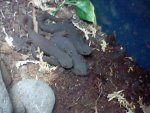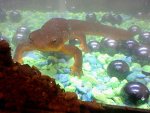Rivethead
New member
The skinny:
Move my two 40gal turtle tanks to create 1 half-wet half-dry vivarium for a couple different Caudate species: a couple newts, a couple salamanders, and a bottom feeder and snails in the water to help keep it clean (snails will double as food, obviously).
The plan is to join the two tanks by putting them face to face, and a “bridge” between them through the opening where the filter would normally rest, that leads directly from the wet to dry side. Please see the grey-ish object in the center of my crudely drawn MS Paint image below. The space between the tanks will be sealed off.

The aquatic side will have some submerged, hand-sculpted terrain, live plants, substrate, etc.
The dry side will have moist substrate, a small pool, and one of those cascading rock thingies.
It’s going to be an open-top vivarium, so I can’t house anything that climbs sheer surfaces or jumps higher than 10 vertical inches.
My questions:
1) Are there any resins, plasters, or other materials that you know would be safe to sculpt the terrain out of? I know natural clay ceramics are safe, but I am looking to make molds and use artificial materials.
2) Do you think any of the amphibians will have trouble navigating the “bridge” when/if needed (assuming I keep the water end below surface level)?
3) Are there species of bottom feeders you would recommend? Naturally I want something to cohabit with my Caudates.
4) If you feel I am making any glaring errors or mistakes, please feel free to mention it.
I’m open to suggestions on species. I am thinking about blue-spotted and/or red-backed salamanders for the mostly-terrestrial species. In terms of aquatic species, all I know is that I find firebellies to be boring and want something more interesting. Does anyone know of any reputable sellers/breeders in Southern Wisconsin?
Move my two 40gal turtle tanks to create 1 half-wet half-dry vivarium for a couple different Caudate species: a couple newts, a couple salamanders, and a bottom feeder and snails in the water to help keep it clean (snails will double as food, obviously).
The plan is to join the two tanks by putting them face to face, and a “bridge” between them through the opening where the filter would normally rest, that leads directly from the wet to dry side. Please see the grey-ish object in the center of my crudely drawn MS Paint image below. The space between the tanks will be sealed off.

The aquatic side will have some submerged, hand-sculpted terrain, live plants, substrate, etc.
The dry side will have moist substrate, a small pool, and one of those cascading rock thingies.
It’s going to be an open-top vivarium, so I can’t house anything that climbs sheer surfaces or jumps higher than 10 vertical inches.
My questions:
1) Are there any resins, plasters, or other materials that you know would be safe to sculpt the terrain out of? I know natural clay ceramics are safe, but I am looking to make molds and use artificial materials.
2) Do you think any of the amphibians will have trouble navigating the “bridge” when/if needed (assuming I keep the water end below surface level)?
3) Are there species of bottom feeders you would recommend? Naturally I want something to cohabit with my Caudates.
4) If you feel I am making any glaring errors or mistakes, please feel free to mention it.
I’m open to suggestions on species. I am thinking about blue-spotted and/or red-backed salamanders for the mostly-terrestrial species. In terms of aquatic species, all I know is that I find firebellies to be boring and want something more interesting. Does anyone know of any reputable sellers/breeders in Southern Wisconsin?



